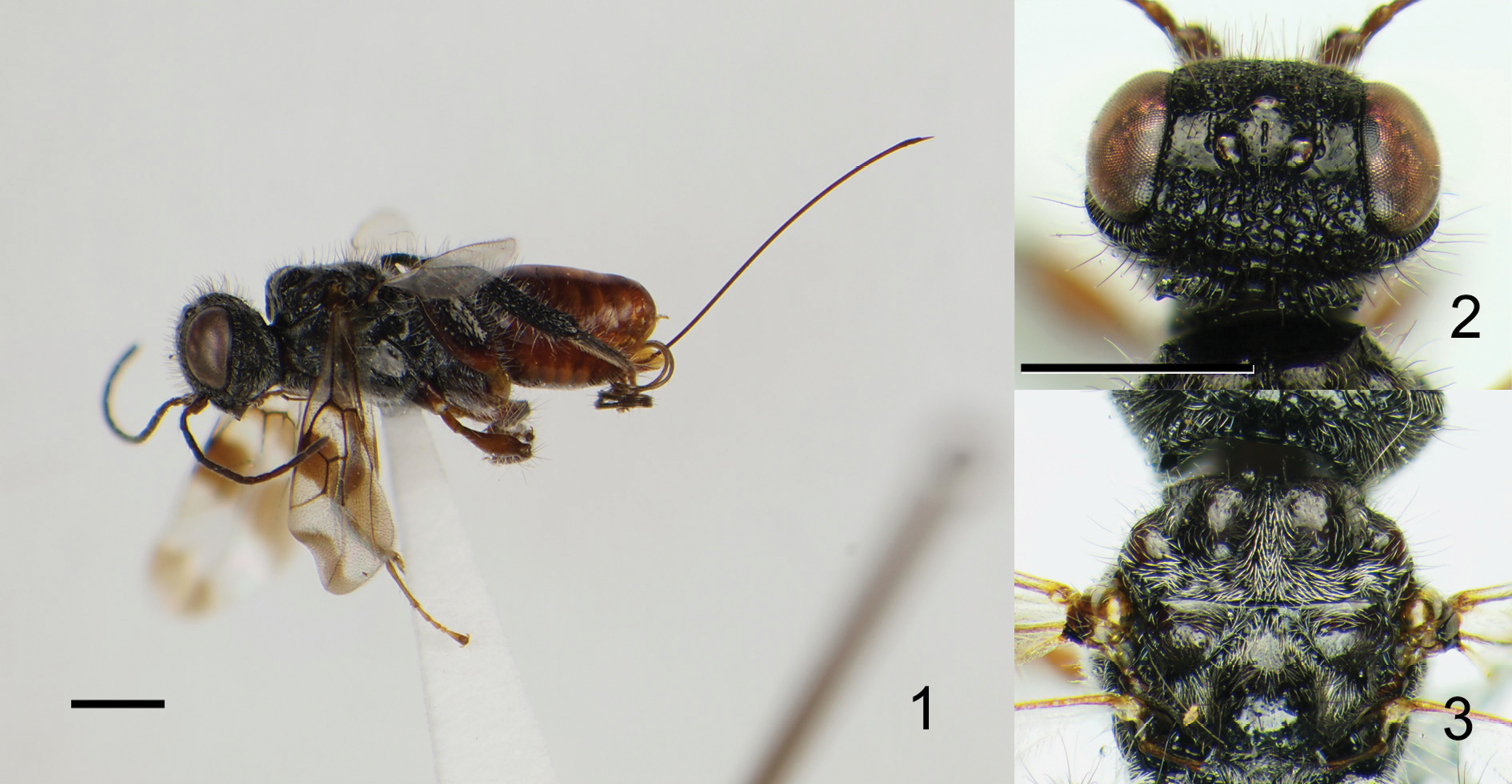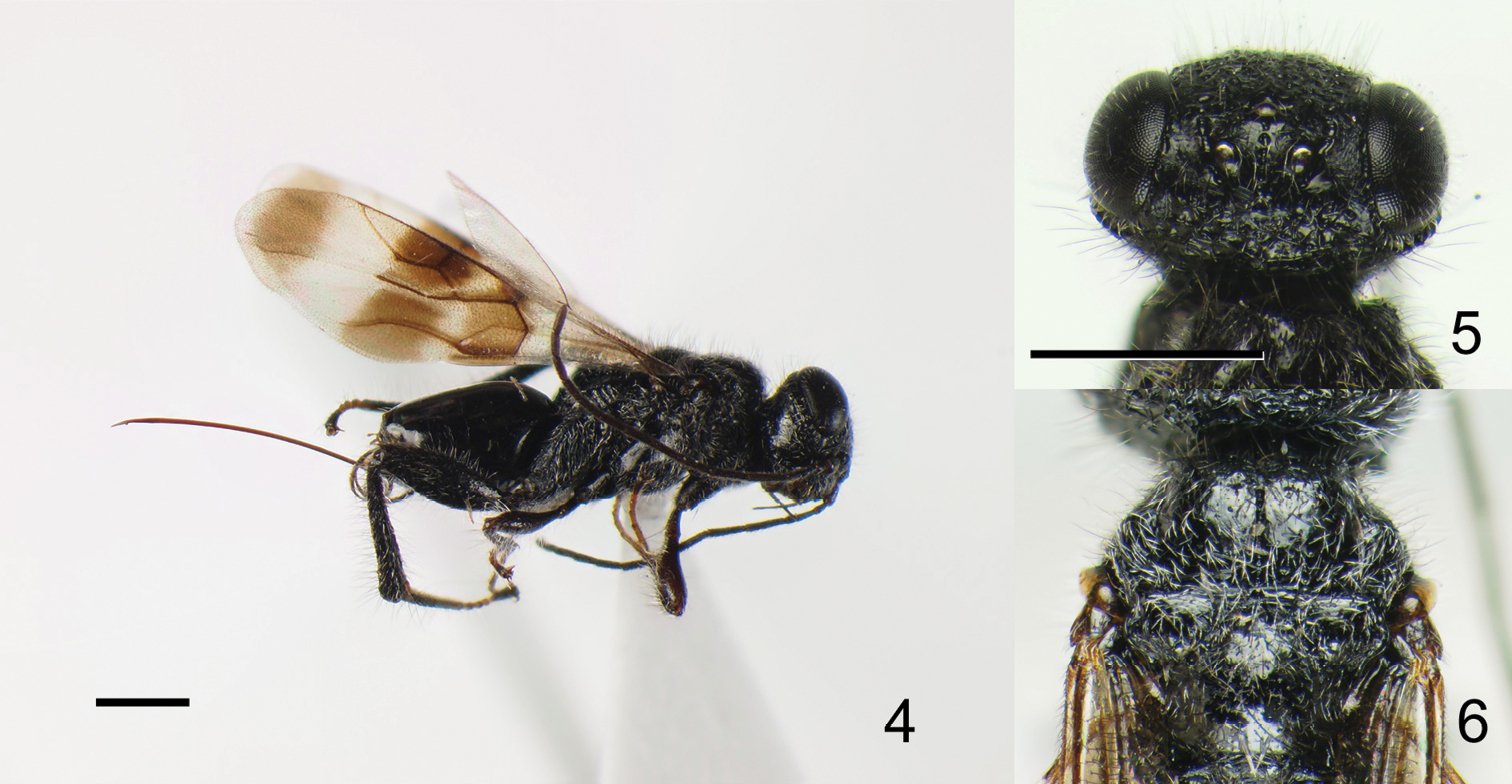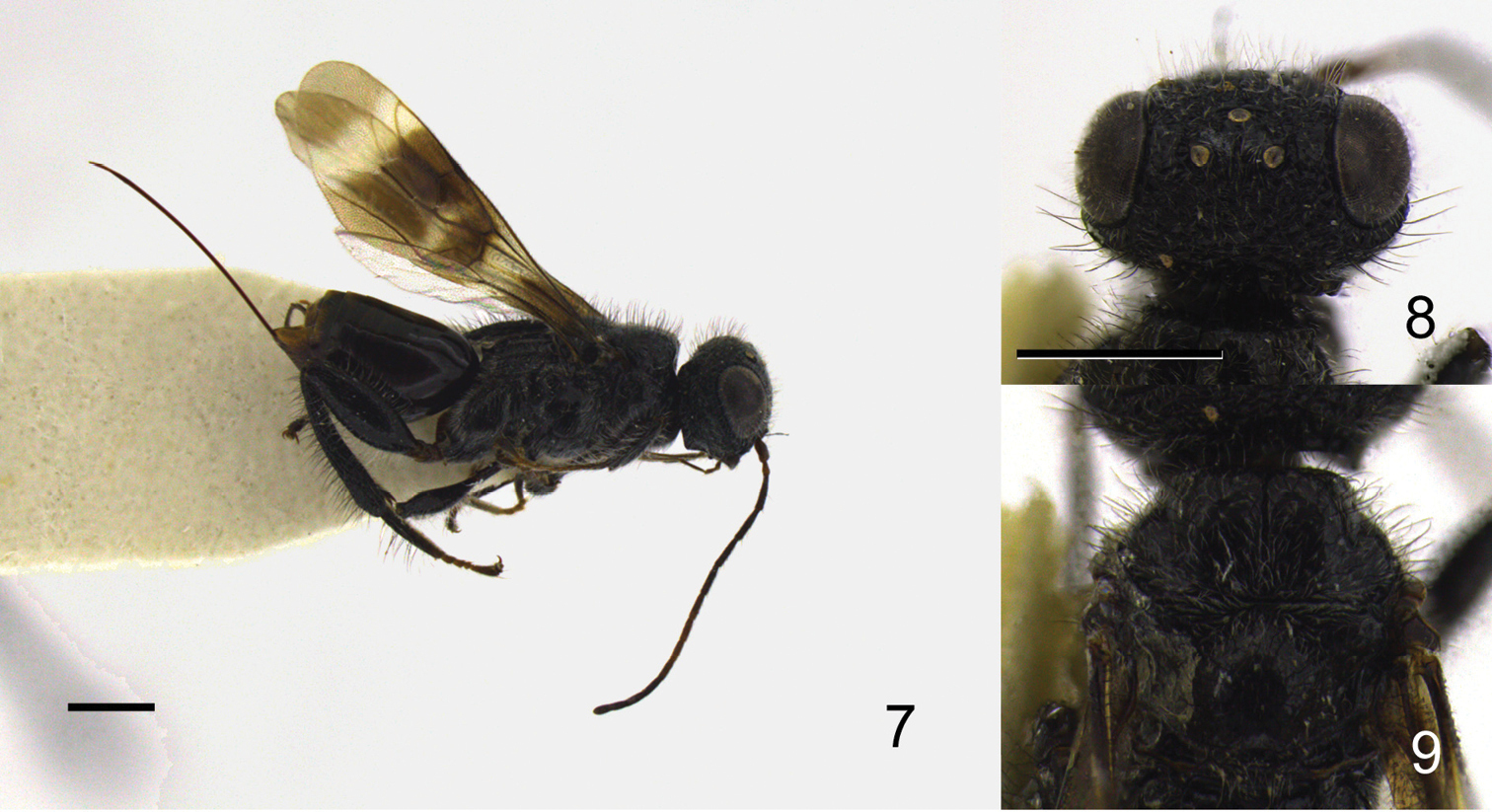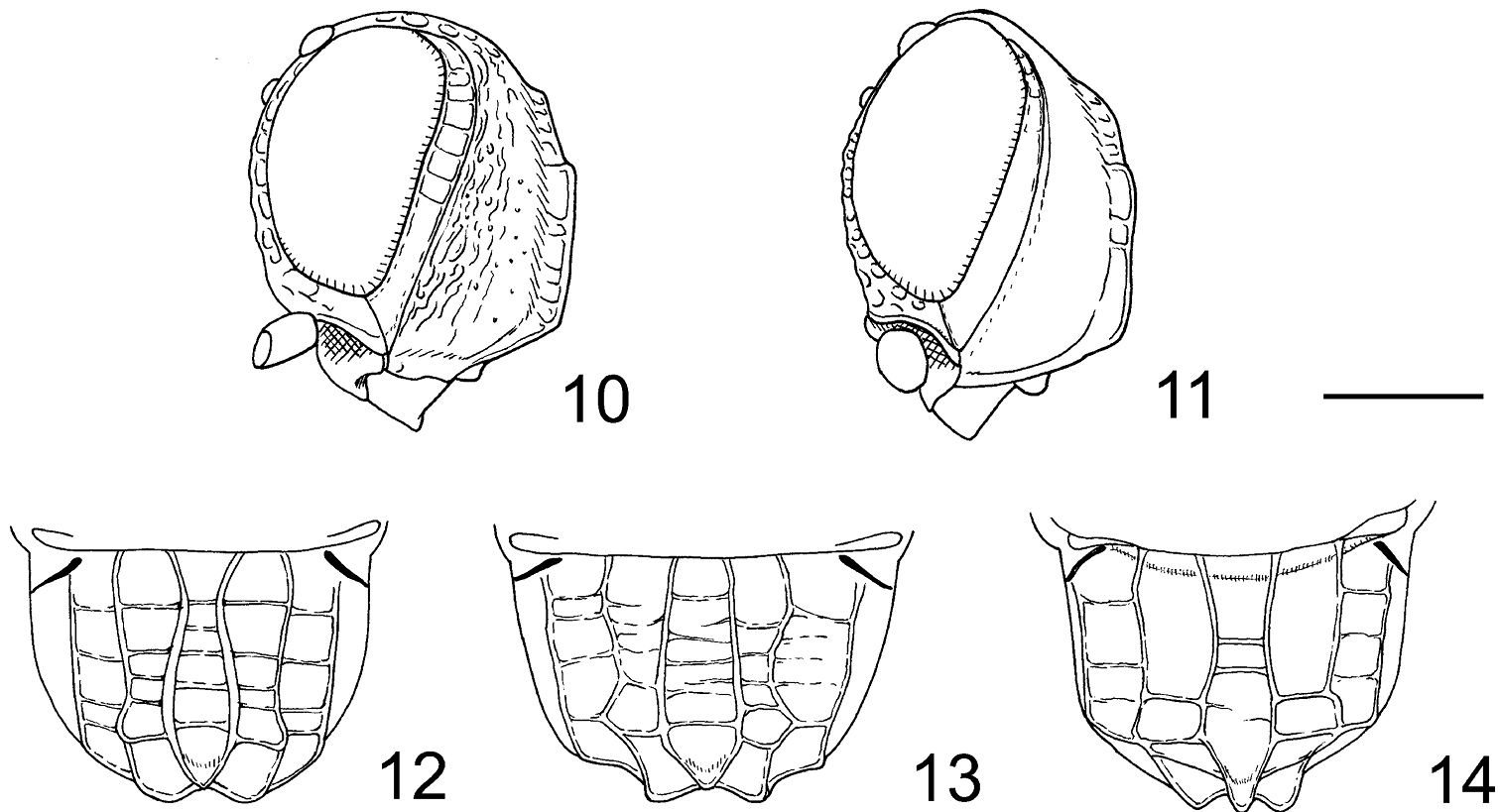






(C) 2012 Toshiharu Mita. This is an open access article distributed under the terms of the Creative Commons Attribution License 3.0 (CC-BY), which permits unrestricted use, distribution, and reproduction in any medium, provided the original author and source are credited.
For reference, use of the paginated PDF or printed version of this article is recommended.
Three new species of Ettchellsia Cameron, namely, Ettchellsia ignita sp. n. from Peninsular Malaysia and Borneo, Ettchellsia nigripes sp. n. from Sulawesi and Ettchellsia reidi sp. n. from Borneo are described and illustrated. A key to the species of Ettchellsia is provided based on females.
Taxonomy, parasitic wasps, South East Asia
The morphological terms used in the descriptions follow
http://species-id.net/wiki/Ettchellsia
Ettchellsia piliceps Cameron, 1909 (monotypic).
Eye margined posteriorly by post-orbital orbital carina; posterior border of mesopleuron smooth, without row of foveae; propodeum bearing unique pattern of longitudinal carinae (Figs 12–14); fuscous banding pattern present on fore wing (Figs 1, 4, 7) or wing entirely fuscous; fore wing with RS between RS+M and r-rs tubular (Fig. 4); apical part of RS tubular, arched toward stigma (Fig. 4); M+Cu and Cu1 spectral (Fig. 4); hind coxa bearing longitudinal carina; hind tibia rugose (Figs 1, 4, 7).
Detail generic character states were discussed by
| 1 | Ocellar triangle smooth, without a longitudinal row of punctures; smooth crescent-shaped depression present on outer margin of each ocellus; wings mostly clear except with some infumation medially and apically, but lacking distinct dark bands | Ettchellsia philippinensis Baltazar |
| – | Ocellar triangle sculptured with at least one median longitudinal row of punctures (Fig. 2); crescent-shaped depressions absent near ocelli, or depressions irregularly foveate, not smooth; wings with three or four distinct dark bands | 2 |
| 2 | Vertex strongly flattened, appearing flat in lateral view (Fig. 11); mesonotum more weakly setose, setae not covering surface | Ettchellsia piliceps Cameron |
| – | Vertex well-developed and convex, appearing round in lateral view (Fig. 10); mesonotum medially and posteriorly with thick setae largely covering surface | 3 |
| 3 | Mesoscutum strongly humped (Fig. 3) | 4 |
| – | Mesoscutum not humped (Fig. 6) | 5 |
| 4 | Median region of propodeum anteriorly strongly narrowed (as in Fig. 12); hind tibia and basitarsi dorsally with long black erect setae, many of which are longer than the width of the hind tibia; metasoma reddish brown (Fig. 1) | Ettchellsia ignita Mita & Shaw, sp. n. |
| – | Median region of propodeum not anteriorly strongly narrowed; hind tibia and basitarsi dorsally with long erect white (not black) setae, most of which are shorter than the width of the hind tibia; metasoma black (as in Fig. 4) | Ettchellsia sinica He |
| 5 | Median region of propodeum medially narrowed (Fig. 14); vertex between posterior ocellus and eye rugose (Fig. 8) | Ettchellsia reidi Mita & Shaw, sp. n. |
| – | Median region of propodeum anteriorly weakly narrowed (Fig. 13); vertex between posterior ocellus and eye mostly smooth (Fig. 5) | Ettchellsia nigripes Mita & Shaw, sp. n. |
urn:lsid:zoobank.org:act:5CDAC4E0-568D-4F4A-A72B-63AA5A4051C2
http://species-id.net/wiki/Ettchellsia_ignita
Figs 1–3, 10, 12Holotype ♀: “MALAYSIA: Negeri Selangor, Ulu Gombak (Univ. Malaya Field Studies Centre, 220m alt) Malaise trap, 7–11.iv.2007 T. Tsuru & M. Maruyama leg.”, “HOLOTYPE: Ettchellsia ignita Mita & Shaw, 2012, sp. n.”. Paratype: 1♂, Sandan, Borneo, Baker leg. The holotype is deposited in the Systematic Entomology, Hokkaido University Museum, Sapporo, Japan (SEHU).The paratype is deposited in the U.S. National Museum of Natural History, Washington D.C, USA (NMNH).
(Female)Head (Figs 1–2) 1.48 × wider than long, covered with long erect setae and short decumbent setae; frons reticulate; surface around ocellar triangle smooth with rows of punctures behind anterior ocellus and outside of posterior ocelli; vertex reticulate-rugose; eye margined posteriorly by foveate groove and single post-ocular orbital carina; gena sparsely punctate with irregular carinae under orbital carina; occipital carina forming a small depression; clypeus transversely rugose.
Mesosoma (Fig. 3) entirely covered with short decumbent white setae, but long erect setae also present on dorsal surface; pronotum dorsally forming acute corner; mesoscutum humped, sparsely scattered with small punctures; lateral carina present on anterior mesoscutal surface; axilla and scutellum sparsely scattered with small punctures; metanotum setose; propodeum (Fig. 12) with pair of median, submedian and lateral carinae; median carina wider than other carinae, dorsal surface flattened (Fig. 12); median propodeal region narrower anteriorly, with several transverse carinae, posterior margin dorsally produced; submedian region with three transverse carinae, medially narrowed; lateral region with four transverse carinae.
Fore wing (Fig. 1) bearing four transverse dark bands; vein M 1.9 × basal part of RS; erect setae on C 0.2 × those on Sc+R and A.
Metasoma smooth but anterior surface of 6th metasomal tergite and 7–8th tergites entirely strongly shagreened; ovipositor 2.00 × mesosoma length, apex with small teeth and single knob.
Color. Head black; mandible black; antenna brown-black except scape and pedicel brownish; long setae on vertex and gena black, other setae white. Mesosoma black except brown tegula; long erect setae black; fore- and middle legs brown; hind leg with coxa, distal half of femur and distal four tarsomeres brown-black, trochanter and basal part of femur brown, tibia and basitarsus black; long setae on dorsal surface of hind tibia and basitarsus black. Metasoma and ovipositor reddish brown; ovipositor sheath pale brown.
Measurements. Head 1.05 mm long, 1.55 mm wide; mesosoma 2.10 mm long; scutum 1.35 mm wide; propodeal disc 0.70 mm long, 1.10 mm wide; fore wing 4.75 mm long; metasoma 2.30 mm long, 1.25 mm wide; ovipositor 4.20 mm long; total body length excluding ovipositor 5.45 mm.
(Male) Different from female as follows: Body brownish, head dark brown with brown antenna, mesosoma brown, legs testaceous excluding brown hind tarsus, metasoma testaceous; median carinae on propodeum narrower, dorsal surface rounded (as in Fig. 13).
Measurements. Head 0.76 mm long, 1.24 mm wide; mesosoma 1.75 mm long; scutum 1.10 mm wide; propodeal disc 0.55 mm long, 0.90 mm wide; fore wing 3.55 mm long; metasoma 1.40 mm long, 0.95 mm wide; total body length 3.77 mm.
Peninsular Malaysia; Borneo.
This species is named for the reddish coloration of the metasoma.
This species is similar to Ettchellsia sinica with both having a strongly humped mesoscutum, however, it is distinguished from the latter by the strongly narrowed median region of propodeum (Fig. 12); long erect black setae on hind tibia and basitarsus, many of which are longer than the width of the hind tibia (setae are whitish and shorter in Ettchellsia sinica); reddish brown metasoma (Fig. 1) (metasoma is black in Ettchellsia sinica).
Ettchellsia ignita, sp. n. (holotype). 1 General habitus 2 Head in dorsal view 3 Mesosoma in dorsal view. Scale = 1.0 mm.
urn:lsid:zoobank.org:act:1B9CC5DE-5AAC-483A-A952-B36A84C5DDFE\
http://species-id.net/wiki/Ettchellsia_nigripes
Figs 4–6, 13♀: “N. Sulawesi: Prov. Gorontalo, Pegunungan Tilongkabila, Bogani Nani Warta Bone N.P., 31. Jan-16 Feb 2010 (alt. 1200m), K. Takasuka leg. (Malaise trap)”, “HOLOTYPE: Ettchellsia nigripes Mita & Shaw, 2012, sp. n.”. The holotype is deposited in the Laboratory of Entomology, Faculty of Agriculture, Tokyo University of Agriculture, Atsugi, Japan.
(Female)Head (Figs 4–5) 1.60 × wider than long, covered with long erect setae and short decumbent white setae; frons transversely rugose; surface around ocellar triangle smooth with rows of punctures behind anterior ocellus and outside of posterior ocelli; vertex reticulate-rugose; eye margined posteriorly by foveate groove and single post-ocular orbital carina; gena smooth with irregular carina under orbital carina; occipital carina not forming a depression; clypeus punctuate with small punctures.
Mesosoma (Fig. 6) entirely covered with short decumbent setae, but long erect setae also present on mesonotum; mesoscutum smooth except lateral carina present on anterior surface; dorsal mesoscutal surface not humped; axilla and scutellum smooth; metanotum setose; propodeum (Figs. 13) with pair of median, submedian and lateral carinae; median region narrowed anteriorly, with eight indistinct transverse carinae, posterior margin posteriorly produced; submedian propodeal region converging posteriorly, with two transverse carinae excluding posterior areola; lateral region with two (right side) or four (left side) transverse carinae.
Fore wing (Fig. 4) bearing four transverse dark bands but separation between second and third bands indistinct; vein M 2.2 × basal part of RS; erect setae on C 1.2 × longer than those on Sc+R, equal to those on vein A.
Metasoma smooth except anterior surface of 6–8th metasomal tergites shagreened; ovipositor 1.29 × mesosoma length, apex with small teeth and single knob.
Color. Body entirely black except tarsi and ovipositor sheath dark brown, ovipositor reddish brown; long setae on vertex, gena, mesonotum and dorsal surface of hind tibia and basitarsus black, other setae white.
Measurements. Head 0.80 mm long, 1.55 mm wide; mesosoma 2.15 mm long; scutum 1.35 mm wide; propodeal disc 0.75 mm long, 1.10 mm wide; fore wing 4.85 mm long; metasoma 1.90 mm long, 1.20 mm wide; ovipositor 2.75 mm long; total body length excluding ovipositor 4.85 mm.
(Male) Unknown.
Sulawesi Island.
This species is named for its black legs.
This species is similar to Ettchellsia reidi Mita & Shaw, sp. n. by the almost flat mesoscutum, however, it is distinguished from the latter by the anteriorly weakly narrowed median region of propodeum (Fig. 13) and the mostly smooth surface between posterior ocellus and eye (Fig. 5).
Ettchellsia nigripes, sp. n. (holotype). 4 General habitus 5 Head in dorsal view 6 Mesosoma in dorsal view. Scale = 1.0 mm.
urn:lsid:zoobank.org:act:403B45A6-E102-41E7-8A52-EBDC05C98BED
http://species-id.net/wiki/Ettchellsia_reidi
Figs 7–9, 14Holotype ♀: “Sungai Sibau, nr entrance to Betung, Kerihun NP. ca. 4 km upstream, Kampung Putan. 21–27 Jun 1996, 70-90m. Chris Reid. IIS 967005”, “20 yr. old lading, closed forest, Pan traps (yellow), 1°03'13"N, 113°00'56"E”, “SEM”, “HOLOTYPE: Ettchellsia reidi Mita & Shaw, 2012”. Paratype: 1♀, same data as above, but Pan traps (yellow) 2:9, without label of “SEM”. The holotype is deposited in the Museum Zoologi Bogor (MZB), the national museum of Indonesia. The paratype is deposited in the Royal Ontario Museum (ROM) Toronto, Canada.
(Female) Head (Figs 7–8) 1.53–1.56 × wider than long, covered with long erect setae and short decumbent white setae; frons transversely rugose; surface around ocellar triangle rugose with rows of punctures behind anterior ocellus and outside of posterior ocelli, but lateral row indistinct among other sculptures; vertex reticulate rugose; eye margined posteriorly by foveate groove and single post-ocular orbital carina; gena smooth with irregular carinae under orbital carina; occipital carina dorso-laterally with a small depression; clypeus smooth.
Mesosoma (Fig. 9) entirely covered with short decumbent setae, but long erect setae also present on mesonotum; mesoscutum smooth; lateral carina present on anterior surface; dorsal surface not swollen; axilla and scutellum smooth; metanotum setose; propodeum (Fig. 14) with pair of median, submedian and lateral carinae; median propodeal region narrower centrally, with a few transverse carinae in holotype, carinae indistinct in a paratype; posterior margin dorsally producing; submedian region smooth excluding posterior areola, parallel-sided; lateral region with at most four transverse carinae but keels sometimes indistinct.
Fore wing (Fig. 7) bearing three transverse dark bands with clear spot around Rs+M; vein M 1.6–1.7 × basal part of RS; erect setae on C 2.0 × those on Sc+R, 1.2 × those on A.
Metasoma smooth except anterior surface of 6–8th metasomal tergites shagreened; ovipositor 1.34–1.45 × mesosoma length, apex with small teeth and single knob.
Color.Head black; mandible dark brown; antenna dark brown except scape, pedicel and 5–8th flagellomeres brown; long setae on vertex, gena black. Mesosoma black; long setae on mesonotum black; legs black except tarsi brownish; long setae on dorsal surface of hind tibia and basitarsus black. Metasoma brownish black; ovipositor and ovipositor sheath dark brown.
Measurements. Head 0.80–1.10 mm long, 1.25–1.65 mm wide; mesosoma 1.55–2.20 mm long; scutum 0.95–1.30 mm wide; propodeal disc 0.65–0.85 mm long, 0.85–1.10 mm wide; fore wing 3.50–4.90 mm long; metasoma 1.55–2.35 mm long, 0.85–1.25 mm wide; ovipositor 2.25–2.95 mm long; total body length excluding ovipositor 3.75–5.45 mm.
(Male) Unknown.
Kalimantan Barat, Borneo.
The species name is dedicated to the collector of the types, Chris Reid, a coleopterist working at the Australian Museum, Sydney.
The specimens were collected as part of the Insects of Indonesia Project, a collaboration of the ROM with the MZB. This species is similar to Ettchellsia nigripes Mita & Shaw, sp. n. About identification of the two species, see the remarks of Ettchellsia nigripes.
Ettchellsia reidi, sp. n. (holotype). 7 General habitus 8 Head in dorsal view 9 Mesosoma in dorsal view. Scale = 1.0 mm.
Heads and propodea of Ettchellsia spp. 10, 12 Ettchellsia ignita, sp. n. 11 Ettchellsia piliceps from Borneo 13 Ettchellsia nigripes, sp. n. 14 Ettchellsia reidi, sp. n. Scale = 0.5 mm.
The authors express cordial thanks to Dr Keizo Takasuka and Mr Kyohei Watanabe from Kobe University, Kobe, Japan for providing the holotype of Ettchellsia nigripes sp. n. We are also grateful to Dr Christopher Darling (ROM), Dr David Smith (NMNH) and Mr. Takuma Yoshida (SEHU) for loaning the type and non-type material. Ms Natalie Dale-Skey Papilloud, Natural History Museum, London, UK loaned an identified female specimen of Ettchellsia piliceps for comparison.



